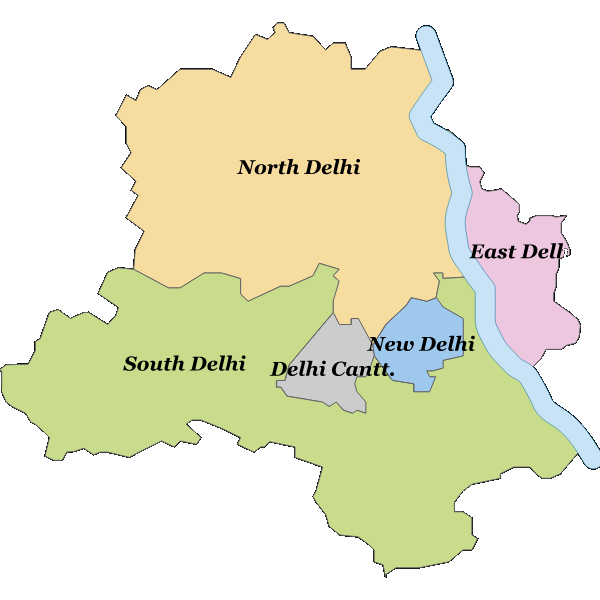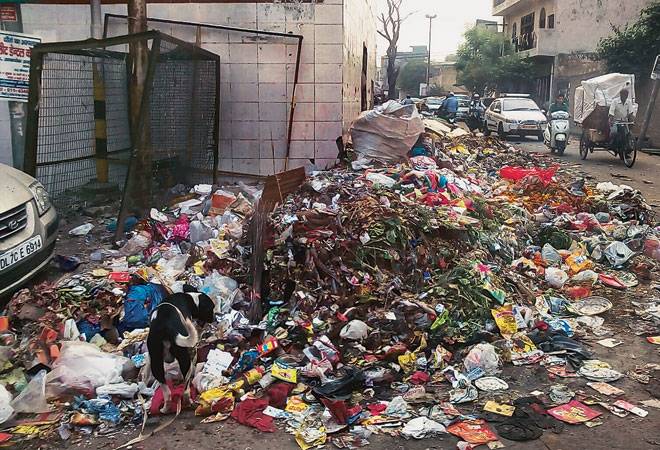Delhi skies are once again overcast with the election season, now with the municipal representatives of the national capital setting the ground with new manifestos. Old manuscripts are being conjured and debates over the structures, powers, and functions of Delhi’s third tier of government have started brewing afresh.
For one, grassroots development in Delhi is a complicated affair, steered by the whims of three different arms of the state. On one hand, the National Capital Territory observes an often-conflicted division of power between the Central Government and the State Government. On the other hand, it also faces hands-on difficulties in crystallizing a clear jurisdiction for the State Government and for its five strands of urban local governance. Be it health emergencies of the highest magnitude as in the COVID-19 pandemic, or the regular hits and misses in the domains of sanitation, local health, local education, and infrastructural development, the citizens of Delhi usually have a hard time understanding whom to hold accountable for the essential quotidian functions they expect of an urban life in the country’s seat of power.

source: wikimedia
The political and administrative history of Delhi narrates the rationale that has segregated the city into five horizontal but distinct units of municipal-level functioning. Besides the New Delhi Municipal Corporation and the Delhi Cantonment Board, the Municipal Corporation of Delhi (MCD), established by the Delhi Municipal Corporation (DMC) Act, 1957 of the Parliament, covers nearly 95% of the capital’s population, and is one of the largest municipal bodies in the world. The absence of full statehood to Delhi ensures that all three of these corporations are directly accountable to the Union Ministry of Home Affairs, circumventing the administrative stronghold of the elected state government. This disconnect between the Centre and the State on Delhi’s local affairs often becomes a bone of contention, especially in light of increased political vehemency among governments at the three federal levels in the past 15 years. More importantly, it is this administrative overlap and confusion that makes Delhi’s long-standing local problems hard to resolve.
An amendment to the DMC Act by the Delhi State Assembly in 2011 led to the trifurcation of the civic body into North, East, and South Delhi Municipal Corporations. The amendment also designated the Secretary of the Urban Development Department of the Delhi Government as the Director of Local Bodies to ensure brisk coordination between the three bodies, giving the state government a greater stake in municipal affairs. However, coordination remains either minimal or abrasive with the direct control of the Centre, owing to which work remains either painstakingly bureaucratic in nature or reduced to petty politics even at the local level.

On top of this discord lies a bigger problem. The trifurcation of the MCD has come with an increased number of employees across hierarchy, thus increasing red-tapism and budgetary requirements. Signalling a continuous stretch of challenges as well as internal clashes, the move to create three different municipal corporations was followed by an inequitable distribution of revenue sources essential for the effective dispensation of their roles and responsibilities. While the recent days have seen a cycle of blame-shifting between the BJP and the AAP around the issue of inadequate allocation of funds for the payment of salaries to local workers, units of the NDMC and the EDMC frequently clash with the SDMC on its control over the maximum tax-paying, affluent colonies. It is not surprising that both these units are marred by revenue deficits. The Northern municipality is unable to compensate the largest number of medical practitioners under its domain working in five major hospitals, the maximum of all three corporations. On the other hand, the Eastern counterpart is challenged by its thousands of unauthorized colonies which lie beyond the ambit of revenue collection. These financial issues are aggravated by non-uniform decision-making and operability leading to an increased trust deficit between the three units.
As funds for disbursement of salaries continue to remain unreleased owing to these institutional conflicts, rampant strikes and other oppositional measures by sanitation workers, doctors, teachers, and other deployed staff cause great distress to the common citizens. One often traverses on roads after roads with piles of garbage decaying for days on end, a sight which serves as a cherry on top of Delhi’s already polluted city-life. Some experts call the 2011 trifurcation of the MCD as the root of all issues when it comes to local governance in the National Capital Territory. Indeed, from a 150-year-old powerful body to a triumvirate of financial imbalances, petulant squabbles and overall lack of coordinated action, all neglecting the plight of its employees and its citizens, the MCD has come a long way in its journey to the 2022 elections.

At the two-year anniversary of the COVID-19 pandemic, as political parties kick their campaigns off and launch themselves before the people, the rationale of local self-governance in Delhi, underlined in the 74th Constitutional Amendment, stands at a critical juncture. For the most part, the need to structurally overhaul the MCD, one of the most pertinent municipal corporations in the country, must gain electoral momentum by gaining space in official political manifestos. Parties may recount achievements at the top, while dismissing the issues on the ground. But only this real, documented will to reform, beyond hue and cry, will carry the election to its promised reality.
Samridhi Chugh is a final-year student of Journalism with Political Science at Lady Shri Ram College for Women.
Interested in exploring the confluence of law, policy and print media, she tends to use the written word as a conduit for her scattered emotions.
She aspires to pursue legal journalism at a near future.


Hi there! Do you use Twitter? I’d like to follow you if that would be okay. I’m undoubtedly enjoying your blog and look forward to new updates.
I’m not sure exactly why but this web site is loading very slow for me. Is anyone else having this issue or is it a problem on my end? I’ll check back later and see if the problem still exists.
Amazing! This blog looks just like my old one! It’s on a entirely different subject but it has pretty much the same page layout and design. Wonderful choice of colors!
Hmm it looks like your blog ate my first comment (it was extremely long) so I guess I’ll just sum it up what I submitted and say, I’m thoroughly enjoying your blog. I too am an aspiring blog blogger but I’m still new to the whole thing. Do you have any suggestions for rookie blog writers? I’d genuinely appreciate it.
I am happy that I noticed this web blog, just the right info that I was looking for! .
What’s Going down i’m new to this, I stumbled upon this I’ve discovered It absolutely helpful and it has helped me out loads. I am hoping to give a contribution & help other customers like its helped me. Great job.